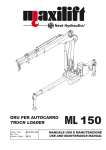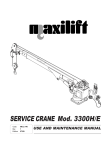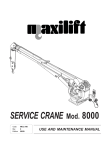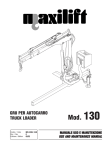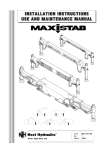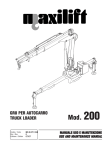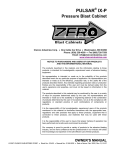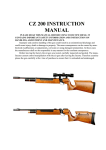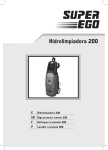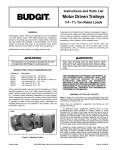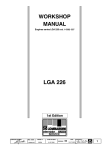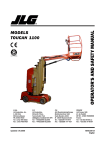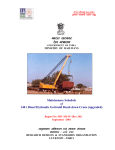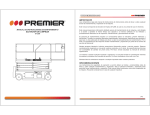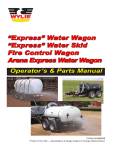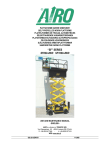Download MD0136 GB.pmd - MAXILIFT and COBRA Truck Cranes. North
Transcript
Mod. M50 USE AND MAINTENANCE MANUAL Code MD.0.136 GB Rev 0 Edition 03/07 Fill in the space below with the required crane identification data. M 50 . 2 Code filling example: M50.2H ELH H E L H M 50 . 2 SERIAL NUMBER: ...................... MANUFACTURING YEAR: ................... Mark the box regarding the accessories supplied with the crane Description Electrical winch Manual winch Stabilizer Back load attachment Quick fitting kit ACCESSORIES SUPPLIED WITH THE CRANE YES NO PRELIMINARY INFORMATION Operator’s and Maintenance Manual of MAXILIFT M50 truck loader. Manual code: MD.0.136 GB This manual is valid starting from serial no: .................... Manufacturer: NEXT HYDRAULICS S.r.l. Via Mediterraneo 6, Boretto (RE)-ITALY In this manual the word “Manufacturer” is referred to “NEXT HYDRAULICS S.r.l.”. List of documentation supplied along with the loader: ¾ Operator’s and Maintenance Manual (for the end user) ¾ Installation Manual (for the installer and the end user) ATTENTION Always carefully read this manual before operating the loader. Most of the accidents occurred during operations are caused by omission of elementary precautions and non fulfilment of the safety instructions. Many accidents can be avoided when their causes are well known and relevant adequate countermeasures are previously taken. INDEX 1 1.1 FOREWORD -------------------------------------------------------------------------------------------- Page -- 1 Remarks ------------------------------------------------------------------------------------------------ “ ----- 1 2 2.1 HOW TO CONSULT THE MANUAL ------------------------------------------------------------------- “ ----- 1 Instructions ------------------------------------------------------------------------------------------------ “ ----- 1 3 3.1 3.3.1 3.2 3.3 3.4 3.4.1 3.4.2 CRANE IDENTIFICATION -------------------------------------------------------------------------------- “ ----- 2 Identification data -------------------------------------------------------------------------------------------- “ ----- 2 Name plate description ------------------------------------------------------------------------------------ “ ----- 2 Main crane components identification ------------------------------------------------------------------ “ ----- 2 Crane composition ------------------------------------------------------------------------------------------ “ ----- 3 Accessories ------------------------------------------------------------------------------------------------ “ ----- 4 Winch ------------------------------------------------------------------------------------------------ “ ----- 4 Stabilizers ------------------------------------------------------------------------------------------------ “ ----- 4 4 4.1 4.2 4.3 COMMISSIONING ----------------------------------------------------------------------------------------- “ ----- 5 Check list before the first commissioning ------------------------------------------------------------- “ ----- 5 Daily check list ---------------------------------------------------------------------------------------------- “ ----- 5 CE Certification ---------------------------------------------------------------------------------------------- “ ----- 5 5 5.1 5.2 5.3 GENERAL SAFETY RULES ----------------------------------------------------------------------------- “ ----- 5 Rules concerning persons --------------------------------------------------------------------------------- “ ----- 5 Rules concerning the crane ------------------------------------------------------------------------------- “ ----- 5 Rules concerning safety in the traffic ------------------------------------------------------------------- “ ----- 6 6 6.1 6.2 6.3 6.4 6.5 6.6 6.6.1 6.6.2 6.6.3 6.6.4 6.6.5 6.6.6 6.6.7 6.6.8 6.6.9 6.6.10 6.6.11 OPERATING INSTRUCTIONS -------------------------------------------------------------------------- “ ----- 7 Daily check list ---------------------------------------------------------------------------------------------- “ ----- 7 Loader classification and proper usage ---------------------------------------------------------------- “ ----- 7 Improper usage ---------------------------------------------------------------------------------------------- “ ----- 7 General attentions ------------------------------------------------------------------------------------------ “ ----- 7 Ten basic rules for the safe loader operator ----------------------------------------------------------- “ ----- 9 Instructions for use ----------------------------------------------------------------------------------------- “ ----- 9 Thrust slewing system ------------------------------------------------------------------------------------- “ ---- 10 Crank slewing system ------------------------------------------------------------------------------------- “ ---- 10 Hydraulic slewing system --------------------------------------------------------------------------------- “ ---- 11 Boom lifting system by mechanic strut ---------------------------------------------------------------- “ ---- 11 Boom lifting system by hydraulic cylinder ------------------------------------------------------------ “ ---- 12 Two manual extensions boom system ----------------------------------------------------------------- “ ---- 13 Boom system with 1st hydraulic and 2nd manual extensions -------------------------------------- “ ---- 14 Hydraulic operating system by hand pump for lifting cylinder ------------------------------------ “ ---- 15 Hydraulic operating system by hand pump for lifting and extension cylinders --------------- “ ---- 16 Hydraulic operating system by hand pump for extension cylinder ------------------------------ “ ---- 17 Electro-hydraulic operating system by power unit with one function for lifting cylinder -------------------------------------------------------------------------------------------- “ ---- 17 Electro-hydraulic operating system by power unit with two functions for lifting and extension cylinders ----------------------------------------------------------------------------------- “ ---- 18 Electro-hydraulic operating system by power unit with two functions for slewing and lifting cylinder ------------------------------------------------------------------------------------------- “ ---- 19 Electro-hydraulic operating system by power unit with three functions for slewing, lifting and extension cylinders ---------------------------------------------------------------------------- “ ---- 20 6.6.12 6.6.13 6.6.14 Via Mediterraneo, 6 - 42022 - Boretto - Reggio Emilia - Italy Tel. +39 - 0522-96 30 08 - Fax +39 - 0522-96 30 39 [email protected] -I- 6.7 6.7.1 6.7.2 6.7.3 6.7.4 6.7.5 6.8 Accessories -------------------------------------------------------------------------------------------- Page - 21 Electrical winch ---------------------------------------------------------------------------------------------- “ ---- 21 Manual winch ------------------------------------------------------------------------------------------------ “ ---- 23 Stabilizer kit ------------------------------------------------------------------------------------------------ “ ---- 24 Back load attachment -------------------------------------------------------------------------------------- “ ---- 24 Quick fitting kit ----------------------------------------------------------------------------------------------- “ ---- 25 Main operating errors --------------------------------------------------------------------------------------- “ ---- 26 7 7.1 7.1.1 7.1.2 MAINTENANCE AND CHECKING --------------------------------------------------------------------- “ ---- 27 Protection and storage ------------------------------------------------------------------------------------- “ ---- 27 Short shutdowns -------------------------------------------------------------------------------------------- “ ---- 27 Long shutdowns --------------------------------------------------------------------------------------------- “ ---- 27 8 8.1 8.1.1 8.2 8.3 8.3.1 8.3.2 8.3.3 8.4 8.4.1 8.4.2 8.4.3 8.4.4 8.4.5 8.5 8.6 MAINTENANCE -------------------------------------------------------------------------------------------- “ ---- 27 Warnings ------------------------------------------------------------------------------------------------ “ ---- 27 Environmental protection ---------------------------------------------------------------------------------- “ ---- 27 Maintenance prescriptions -------------------------------------------------------------------------------- “ ---- 27 Maintenance schedule ------------------------------------------------------------------------------------- “ ---- 29 Check list before a working session -------------------------------------------------------------------- “ ---- 29 Quarterly checking ------------------------------------------------------------------------------------------ “ ---- 29 Yearly checking ---------------------------------------------------------------------------------------------- “ ---- 29 Loader servicing --------------------------------------------------------------------------------------------- “ ---- 29 Oil level checking -------------------------------------------------------------------------------------------- “ ---- 30 Oil change ------------------------------------------------------------------------------------------------ “ ---- 30 Wear pads checks and replacement ------------------------------------------------------------------- “ ---- 30 Worm gear assembly control ----------------------------------------------------------------------------- “ ---- 31 Thrust rotation brake control ------------------------------------------------------------------------------ “ ---- 31 Electric winch maintenance ------------------------------------------------------------------------------ “ ---- 31 Greases and oils reference table ------------------------------------------------------------------------ “ ---- 32 9 9.1 9.2 9.3 9.4 9.4.1 9.4.2 9.4.3 TECHNICAL DATA ---------------------------------------------------------------------------------------- “ ---- 33 Crane overall dimensions ---------------------------------------------------------------------------------- “ ---- 33 Stabilizer overall dimensions ----------------------------------------------------------------------------- “ ---- 33 Load chart tables -------------------------------------------------------------------------------------------- “ ---- 34 Technical specifications ----------------------------------------------------------------------------------- “ ---- 34 Technical data table ---------------------------------------------------------------------------------------- “ ---- 34 Table of weights for foreseen crane versions ---------------------------------------------------------- “ ---- 35 Accessories weights table -------------------------------------------------------------------------------- “ ---- 35 10 10.1 10.2 WIRING AND HYDRAULIC DIAGRAMS ------------------------------------------------------------- “ ---- 35 Hydraulic diagram hand pump for lifting cylinder ----------------------------------------------------- “ ---- 35 Hydraulic diagram hand pump + valve bank for lifting and extension cylinders ----------------------------------------------------------------------------------- “ ---- 36 Hydraulic diagram hand pump + valve bank for extension cylinder ------------------------------ “ ---- 36 Electro-hydraulic diagram motor pump for lifting cylinder ------------------------------------------ “ ---- 37 Electro-hydraulic diagram motor pump for lifting and extension cylinders --------------------- “ ---- 37 Electro-hydraulic diagram motor pump for slewing and extension cylinder ------------------- “ ---- 38 Electro-hydraulic diagram motor pump for slewing, lifting and extension cylinders ---------------------------------------------------------------------------- “ ---- 38 Electrical winch wiring diagram -------------------------------------------------------------------------- “ ---- 39 10.3 10.4 10.5 10.6 10.7 10.8 - II - Via Mediterraneo, 6 - 42022 - Boretto - Reggio Emilia - Italy Tel. +39 - 0522-96 30 08 - Fax +39 - 0522-96 30 39 [email protected] 1 1.1 FOREWORD Remarks This manual gives the guidelines for a correct, safe usage of the loader and its rational maintenance. When daily and constantly applied, these guidelines ensure long service life with minimum maintenance costs, high performance of the loader and good commercial value after years. Moreover, most of the frequent accidents during operation and servicing are avoided. Once this manual has been read carefully, keep it in good conditions and quickly available close to the loader. ATTENTION Should some or any part of this manual be not clear, please contact the Manufacturer NOTE The table on the back of the front page has to be filled at customer’s care. It contains all the necessary data required when calling our Technical Service. A copy of this manual is supplied along with every loader. Data, descriptions and pictures of this manual are not binding. The Manufacturer reserves the right to change at any time all the items, components and parts deemed to be necessary for product improvement or commercial or production needs.. 2 2.1 HOW TO CONSULT THE MANUAL Instructions Always carefully read this manual before operating the loader. The manual must be entirely read, except for chapter 6, whose paragraphs must be compulsorily read up to 6.5 inclusive. Paragraph 6.6 contains the instructions for use for all those units that may constitute the machine, and which are represented in the picture of paragraph 3.3. To simplify reading this last one, it is necessary to determine all the units making up one’s machine, and to read only the concerning sub-paragraphs. Actually, relevant legend includes the corresponding sub-paragraph beside the name of every single unit. Paragraph 6.7 contains the instructions for use for accessories, among which it is necessary to single out those provided with one’s machine, in order to read relevant the sub-paragraphs. We suggest to cross all the parts of the manual that do not apply to one’s loader. In this manual the following symbols are used: ! DANGER Referred to dangers related to the described activity, when the safety of people is concerned. ATTENTION Referred to dangers related to the described activity, mainly when the safety of things is concerned (for instance, damage of the load or of the loader). IMPORTANT Referred to information or integration on loader operation. NOTE Used to draw your attention on information or suggestions to make easier the loader usage for the operator. The symbols and marks are completed with notices stating the dangers, their nature, the avoidance actions to be taken and tips to be followed. Via Mediterraneo, 6 - 42022 - Boretto - Reggio Emilia - Italy Tel. +39 - 0522-96 30 08 - Fax +39 - 0522-96 30 39 [email protected] -1- 3 3.1 CRANE IDENTIFICATION Identification data Every loader is identified by its serial number and name of the model written on the plate riveted on the column (Pict. 1). 3.1.1 Name plate description ¾ ¾ ¾ ¾ ¾ ¾ Crane model Serial number Year of manufacturing Lifting class Max SWL [kg] Max SWL [lbs] ATTENTION It is strictly forbidden to change and/ or erase the data written on the name plate. 3.2 Pict. 1 Main crane components identification The main components of a telescopic boom crane are (pict. 2): ¾ ¾ ¾ ¾ Motor pump Slewing support Column Boom assembly Operating system Boom Extension cylinder 1st extension The full crane structure is positioned and slews over the rotation support, which is consequently the slewing system housing. The column is the slewing component on which the most important articulation fulcrums allowing boom lifting are located. The boom can be lifted in two ways: ¾ hydraulically, by means of a lifting cylinder; ¾ manually, by keeping it in fixed position by means of a mechanical support strut. The boom assembly is the element allowing load recovering and hooking. It is consisting of: ¾ boom, on which the articulation fulcrums are located; ¾ extensions, allowing its in & out movements (manual or hydraulic by means of a cylinder); ¾ hook attachment. -2- Button strip 2nd extension Control valve bank Lifting cylinder Slewing support Mechanical strut Hook attachment Hand pump Crank slewing device Hydraulic slewing device Via Mediterraneo, 6 - 42022 - Boretto - Reggio Emilia - Italy Tel. +39 - 0522-96 30 08 - Fax +39 - 0522-96 30 39 [email protected] Braking device for thrust rotation Pict. 2 Finally, the operating system is the hydraulic or electro-hydraulic system transmitting the movement to the actuators (cylinders). It is consisting of a pump (electric or manual) and control system (button strip or hydraulic valve bank). In this type of crane the slewing support and column assembly make up the slewing system, which can be of three types: ¾ thrust rotation; ¾ crank rotation (operating a worm screw – worm wheel gear); ¾ hydraulic (hydraulic motor operating a worm screw – worm wheel gear). 3.3 Crane composition Bo om sy ste m Pict. 3 C2 C1 Lift ing B1 A1 A2 Sle win y gs ste B2 m A3 Operating system D1 A1 A2 A3 B1 B2 C1 C2 D1 D2 D3 D4 D5 D6 D2 D3 D4 D5 D6 Thrust slewing system (6.6.1) Crank slewing system (6.6.2) Hydraulic slewing system (6.6.3) Boom lifting system by mechanical strut (6.6.4) Boom lifting system by hydraulic cylinder (6.6.5) Two manual extensions boom system (6.6.6) Boom system with 1st hydraulic and 2nd manual extensions (6.6.7) Hydraulic operating system with hand pump for lifting cylinder (6.6.8) Hydraulic operating system with hand pump for lifting and extension cylinders (6.6.9) Hydraulic operating system with hand pump for extension cylinder (6.6.10) Electro-hydraulic operating system by power unit with single function for lifting cylinder (6.6.11) Electro-hydraulic operating system by power unit with two functions for lifting and extension cylinders (6.6.12) or for slewing and lifting cylinder (6.6.13) Electro-hydraulic operating system by power unit with three functions for slewing, lifting and extension cylinders (6.6.14) Via Mediterraneo, 6 - 42022 - Boretto - Reggio Emilia - Italy Tel. +39 - 0522-96 30 08 - Fax +39 - 0522-96 30 39 [email protected] -3- 3.4 Accessories According to crane use, there are accessories whose application is not compulsory, but which are essential in some cases. These are: Manual winch Stabilizer Electrical winch Back load attachment Quick fitting system Pict. 4 ¾ Winch (see chap. 6.7.1 for electrical winch and 6.7.2. for the manual winch); ¾ Stabilizers (see chap. 6.7.3). The merely optional accessories are: ¾ Back load attachment (see chap. 6.7.4). ¾ Quick fitting kit (see chap. 6.7.5). 3.4.1 Winch The winch is a rope lifting device, which is installed on the crane boom, through proper fastening, and which together with the transmission, coupling and safety devices, becomes an integral part of it The winch is an accessory allowing the vertical load handling. On cranes equipped with mechanic strut, the winch is no longer an accessory, rather an essential component, as it is the only available lifting device. On this crane, the winch can be either mechanical or electrical, and relevant instructions are reported respectively in sub-paragraphs 6.7.1 and 6.7.2. 3.4.2 Stabilizers The stabilizers are installed on the vehicle to increase stability and prevent overturning. The stabilizers are consisting of rods to whose end a stabilizer leg is applied; such leg is an extendable telescopic tube which lowers and leans on the ground by a plate. Such rods can be either fixed or extendable from a tube fixed on the vehicle, called main beam; the rod locking in this case is made by means of an automatic hooking device. The stabilizer’s instructions for use are listed in sub-paragraph 6.7.3. -4- Via Mediterraneo, 6 - 42022 - Boretto - Reggio Emilia - Italy Tel. +39 - 0522-96 30 08 - Fax +39 - 0522-96 30 39 [email protected] 4 4.1 COMMISSIONING Check list before the first commissioning Check that the crane is complete of: ¾ CE declaration of conformity of the crane manufacturer; ¾ CE declaration of conformity of the crane installing workshop or self-certification of installation performed according to Manufacturer’s installation instructions; ¾ Operator’s and maintenance manual; ¾ other testing certificates according to Safety Law in force. 4.2 ¾ ¾ ¾ ¾ ¾ Daily check list Check the existence of oil leaks; Check the correct working of all crane safety devices (as indicated in relevant paragraph); Check oil level and fill up if necessary; Check the good conditions of hoses and piping; Check the good conditions of the rope. 4.3 CE Certification Fill in the CE certification document with the required crane identification data. 5 5.1 ¾ ¾ ¾ ¾ ¾ ¾ ¾ ¾ ¾ ¾ ¾ Rules concerning persons Always wear the prescribed personal safety devices. Always wear approved accident-prevention clothing such as: protective helmets, anti-slip shoes, protective gloves, reflective jackets, breathing apparatus and protective glasses. Consult your employer regarding current safety regulations and accident-prevention equipment. Do not wear rings, wristwatches, jewellery, loose-fitting or hanging clothing such as ties, torn garments, scarves, unbuttoned jackets or unzipped overalls which could get caught up by parts in motion. Keep quickly and readily available on the truck a first-aid box and a fire extinguisher. The fire extinguisher must always be kept charged and has to be used according to current regulations. 5.2 ¾ GENERAL SAFETY RULES Rules concerning the crane The Manufacturer is not liable for accidents occurred when using the crane caused by non fulfilment from the operator’s side of current rules, laws and regulations. The regular crane functioning is guaranteed within a temperature range between 0°C and +40°C. If temperature drops under 0°C, it is essential to replace the oil in the whole circuit by a less viscous one, as indicated in the suggested oil table. Carefully read the Operator’s and maintenance manual before commissioning, using, servicing or doing any thing on the loader. Read and follow all safety instruction plates applied on the loader before starting up, using, servicing or doing any thing on the loader. If the crane is provided with electrical devices, before operating the loader make sure that its voltage (12V) is same as the vehicle one. Do not use controls and hoses as handholds: these parts move and cannot provide stable support. The operator’s control desk must always be kept clean from oil, grease, mud and snow to avoid accidents due to slippery surfaces. The safety instruction plates, notices, load charts and any other sticker applied on the loader must be kept readable and in good conditions. If necessary, replace them. The position of these plates is shown in pict. 5. Via Mediterraneo, 6 - 42022 - Boretto - Reggio Emilia - Italy Tel. +39 - 0522-96 30 08 - Fax +39 - 0522-96 30 39 [email protected] -5- 10 6 5 7 8 13 14 MAX Kg200 12 3 9 1 15 12 11 12V 16 2 5.3 ¾ ¾ 4 Pict. 5 Rules concerning safety in the traffic The machine is an hydraulic loader for lorries and light trucks. The installation on the vehicle must be made in compliance with the relevant national laws and regulations. When travelling on roads and public sites always respect the relevant national laws and regulations. ! DANGER Before travelling on roads, make sure that the loader is folded in rest position. If the loader is open or lying on vehicle’s body exceeding the overall dimensions allowed by the highway code, it can hit bridges, electric power lines or other obstructions. ¾ ¾ Before driving away, make sure that the levers and the pins securing the outrigger’s beam are fully locked. Accidental slipping out of the outrigger beam during travelling can result in serious accidents. Special care must be taken when driving nearby crossroads, level-crossings and subways. -6- Via Mediterraneo, 6 - 42022 - Boretto - Reggio Emilia - Italy Tel. +39 - 0522-96 30 08 - Fax +39 - 0522-96 30 39 [email protected] 6 6.1 ¾ ¾ ¾ ¾ ¾ ¾ OPERATING INSTRUCTIONS Daily check list Check the existence of oil leaks; Check the correct working of the load limiting device, if installed (see on relevant paragraph); Check oil level and fill up if necessary; Check the good conditions of hoses and piping; Check the good conditions of the winch rope; Check the efficiency of thrust rotation brake 6.2 Loader classification and proper usage The machine is an hydraulic truck loader for hook service. It can also be used for the same purpose from a static mounting. The lifting capacity is 5 kNm, making it especially suitable for installation on light truck. The crane is classified in class H1-B1 according to DIN 15018 standards, and must be used accordingly, that is: trucks loading/unloading, hook service. 6.3 Improper usages It is forbidden: ¾ To use the loader in different operations from those it has been designed and built for. (see above point 6.2). ¾ To use the loader with attachment like: grabs, clamshells, magnets and so on. ¾ Pulling loads with loader in horizontal position. ¾ Crane operation with procedures not specified in this manual, or using components not foreseen during the design phase. ¾ Non observance of the established maintenance programs. ¾ Non observance of safety rules. ¾ Perform interventions on the machine that imply the modification of components or parameters that influence the working cycle. ¾ The unauthorized use of captive spare parts and components not specifically approved by the Manufacturer. ¾ To carry out modifications or structural interventions without the approval of the Manufacturer. ¾ To operate the loader out of the admissible range of temperatures. Any of the above mentioned improper usages or non observance will cause: ¾ immediate cancellation of the Manufacturer Warranty. ¾ cancellation of Manufacturer liability for damage of people, animals, things. ATTENTION The improper usage can damage the loader and subsequently result in dangerous situations for the staff entitled to its operation. 6.4 General attentions ! DANGER Before starting operations make sure that nobody is in the working area of the loader. Preliminary prescriptions: ¾ ¾ The crane must work only if stabilized on flat and thick ground. Make sure that the truck is well braked and, if necessary, apply chocks to the tires. If mechanical stabilizers are used: ¾ Pull the outrigger’s beams out of their housing till the yellow line painted on it is completely visible, and make sure that the safety pins on the box are perfectly hooked on the beams. ¾ Lower the outriggers pads down to the ground. Be sure of not entirely lifting up the truck suspensions. It is important for the truck stability that a part of the truck weight still burdens on the tires. Via Mediterraneo, 6 - 42022 - Boretto - Reggio Emilia - Italy Tel. +39 - 0522-96 30 08 - Fax +39 - 0522-96 30 39 [email protected] -7- ¾ Never operate the crane without having checked that the outriggers are well positioned on firm ground. If necessary, their bearing area must be increased with additional pads. The truck stability relies very much on the working conditions! When the ground under the outrigger pads is sinking, their bearing area must be increased. The crane Manufacturer can supply additional plates on request with increased area. Before starting operations: ¾ Make sure that lifted loads do not exceed the allowed ones for every outreach. ¾ Make sure that the extension lock pins are correctly inserted and safely locked by their retainers (see pictures 9, 11, 12, 21, 25). While operating: ¾ ¾ ¾ ¾ ¾ ¾ ¾ ¾ Lifting tackles, chains or ropes must be applied to the hook in such a way that will not damage the hook safety latch. Avoid sudden movements especially during descent. Whilst swinging the boom always keep the load suspended from the ground. Dragging of the load is forbidden. Never stay or walk under hanging loads. Never start the loader operation without signalling it in a proper way. The load should never be lifted or carried on areas where people are passing or working. If this cannot be avoided in any way, these operations must be properly signalled. Before leaving the controls, make sure that the control levers are in neutral position, and the load is resting on the ground. When the working area of the crane cannot be clearly seen from the operator control deck, a second operator charged with signalling is required. General instructions: ¾ ¾ ¾ ¾ ¾ ¾ ¾ The stickers and plates applied on the loader are necessary to enable a safe usage of the same. Should them be no longer readable, replace them as soon as possible by new ones. If the loader is accidentally hit, it has to be checked and tested from the closest authorized installer workshop. Check every month the state and correct functioning of all the parts subject to wear: pins, valves, hoses, sliding pads and bushings, etc. If necessary replace by Original Spare Parts. It is absolutely forbidden to tamper with the hydraulic circuit and open the safety seals. Failure to comply will cause automatically the voiding of any warranty on the product. Valves adjustments or setting must be done only by authorized installer workshops. It is absolutely forbidden to tamper with electrical parts, winches, lockpins and their housings. Carefully check conditions and wear of the rope and its couplings. Check the conditions of the hook and its safety latch. Loader driven by DC power pack: The DC power pack is connected with the truck battery. The electric pump will start, or will have to be started, each time a lever of the control valve is moved. The loader can work for short periods even when the engine of the truck is off, but it is strongly recommended to keep the engine idling, so the alternator can continuously charge the battery of the vehicle. ! DANGER DC electric motor overheating. Keep the electric pump running for short periods to avoid its over heating. The maximum working period of the pump depends on the pressure requested by the manoeuvres, but should never exceed 5 minutes in any case, with intervals of 20 min. to enable a sufficient cooling. ATTENTION It is advisable to start the vehicle engine to avoid running down the battery when operating in a ventilated area without any fire or explosion risks. Stabilizing the truck: ¾ ¾ ¾ Bearing in mind the job to be done, the vehicle has to be positioned in the most convenient position, stopped with the parking brake and the tires blocked. The truck engine shall be kept idling to allow batteries’ recharging. Extend the outriggers’ beams. -8- Via Mediterraneo, 6 - 42022 - Boretto - Reggio Emilia - Italy Tel. +39 - 0522-96 30 08 - Fax +39 - 0522-96 30 39 [email protected] Always extend fully the outrigger beams to their working position (i.e.: maximum opening position), when foreseen, to grant the maximum stability of the vehicle and safety. ATTENTION The outrigger beams are in their working position when the yellow band existing on every beam can be entirely seen. 6.5 Ten basic rules for the safe loader operator Always comply with the following ten basic rules: ¾ When approaching the crane for the first time, become on familiar terms with it, executing all the manoeuvres the loader can perform during working. ¾ Carefully read all the prescriptions of this manual and execute step by step the activities hereby described to be sure of the correct understanding. ¾ This manual must always be carried in the driver’s cab along with a copy of the load chart. ¾ Study and plan the best way to operate the crane: soil consistence, weight and dimensions of the loads to be lifted, height to be raised and necessary booms outreach. Check available room or limitations due to the presence of buildings, obstacles, electricity power lines, etc. ¾ Make sure of availability of all the necessary equipment : accident-prevention clothing, additional bearing plates with increased surface area, slings, hooks, ropes and chains of certified origin and in perfect conditions. ¾ Before starting loader operations check the efficiency of the safety control devices. Never use the loader if the correct functioning of a device is not sure. ¾ Traffic and safety laws in force must be strictly observed both when travelling on road and when operating the loader. ¾ The warnings of these manual referred to special dangers are to be read and observed with special care. ¾ The safety during the loader service must be kept to the highest level carrying out a regular, constant and accurate preventive maintenance. ¾ Repairs if necessary should never be delayed, and must be made by specialized, authorized people using only genuine spare parts. 6.6 Instructions for use The crane instructions for use are based on the analysis of the different functioning units Find your own version in the following table. that are combining each other according to The sub-paragraphs that must be compulsorily read for using the crane are indicated beside of it. the versions. The main units are: VERSION Paragraphs ¾ Thrust slewing system M50.2M MSF VE (VM) 6.6.1 – 6.6.4 – 6.6.6 – 6.7.1/6.7.2 ¾ Crank slewing system M50.2M MLF VE (VM) 6.6.2 - 6.6.4 – 6.6.6 – 6.7.1/6.7.2 ¾ Hydraulic slewing system M50.2H PSF VE (VM) 6.6.1 – 6.6.4 – 6.6.5 – 6.6.10 – 6.7.1/6.7.2 ¾ Boom lifting system by mechanical strut M50.2H PLF VE (VM) 6.6.2 – 6.6.4 – 6.6.5 – 6.6.10 – 6.7.1/6.7.2 ¾ Boom lifting system by hydraulic M50.2M PSH 6.6.1 – 6.6.5 – 6.6.6 – 6.6.8 cylinder M50.2M PLH 6.6.2 – 6.6.5 – 6.6.6 – 6.6.8 ¾ Lifting system by electrical winch M50.2M ESH 6.6.1 – 6.6.5 – 6.6.6 – 6.6.11 ¾ Lifting system by manual winch M50.2M ELH 6.6.2 – 6.6.5 – 6.6.6 – 6.6.11 ¾ Two manual extension boom system M50.2H PSH 6.6.1 – 6.6.5 – 6.6.7 – 6.6.9 st nd ¾ Boom system with 1 hydraulic and 2 M50.2H PLH 6.6.2 – 6.6.5 – 6.6.7 – 6.6.9 manual extensions M50.2H ELH 6.6.2 – 6.6.5 – 6.6.7 – 6.6.12 ¾ Hydraulic operating system by hand M50.2M ERH 6.6.3 – 6.6.5 – 6.6.7 – 6.6.13 pump for lifting cylinder M50.2H ERH 6.6.3 – 6.6.5 – 6.6.7 – 6.6.14 ¾ Hydraulic operating system by hand pump for extension cylinder ¾ Hydraulic operating system by hand pump for lifting and extension cylinders ¾ Electro-hydraulic operating system by power unit with single function for lifting cylinder ¾ Electro-hydraulic operating system by power unit with two functions for lifting and extension cylinders ¾ Electro-hydraulic operating system by power unit with two functions for slewing and lifting cylinder ¾ Electro-hydraulic operating system by power unit with three functions for slewing, lifting and extension cylinders Via Mediterraneo, 6 - 42022 - Boretto - Reggio Emilia - Italy Tel. +39 - 0522-96 30 08 - Fax +39 - 0522-96 30 39 [email protected] -9- 6.6.1 Thrust rotation system Operation: The thrust rotation system is so called because the operator performs column rotation by pushing on crane arm. The system is supported by a friction braking device (pict. 6). It is consisting of a block which is locked by a lever on a plastic ring fixed on the slewing column. Screw Ring Braking block lever Use: ¾ Before lifting a load, check braking system efficiency by tightening the lever and trying to push the boom without load. ¾ The operator has to push the crane boom in one Pict. 6 sense or the other to perform the slewing. ¾ After the slewing and before performing the vertical load translation with the winch, or lifting by the cylinder, tighten further the brake lever to prevent any slewing caused by load swinging or hunting. After use: ¾ Shelter the crane in the min. overall volume position; ¾ Tighten the brake lever to lock the slewing, in order to prevent it from triggering spontaneously when the vehicle is on the road due to the forces of inertia. ! DANGERS To perform the thrust slewing, the brake lever must be tightened; the crane must rotate only if pushed by the operator. Keep as far from the load as possible while it is being handled, always making sure that no part of the body is below of it, especially in case of load hunting. We advise against choosing this slewing system in all situations where the crane base may be leaning compared with the horizontal line. Do not lubricate or grease either the block or the plastic ring; this causes a braking reduction. 6.6.2 Crank rotation system Operation: This system is consisting of a worm screw/worm wheel gearing protected by a casing and driven by a crank (pict. 7). Use: To operate the system, it is necessary to: ¾ insert the crank in the proper housing made in the worm screw; ¾ turn in either sense. After use: After the crane has been used, or before re-starting off, pull out the crank and put it back in the lever holder of the hand pump support. If the crane is not provided with hand pump, put the crank inside the boom assembly or in the tools compartment. Casing Crank ! DANGERS Make sure that the slewing stop prevents excessive traction stresses on the hydraulic hoses . Pict. 7 - 10 - Via Mediterraneo, 6 - 42022 - Boretto - Reggio Emilia - Italy Tel. +39 - 0522-96 30 08 - Fax +39 - 0522-96 30 39 [email protected] 6.6.3 Hydraulic slewing system Operation: This system is fulfilled with a worm/crown gearing protected by a casing and operated by an hydraulic motor (pict. 8). Such motor is energized by the operating system consisting of an electro-hydraulic power unit and a control valve bank. Casing Use: To start the system you have to: ¾ plug in the battery disconnector of the operating system; ¾ operate the corresponding lever on the valve bank while pushing the motor ignition switch. After use: Shelter the crane in the min. overall volume position, so that it does not protrude from vehicle’s profile. ! DANGERS Make sure that the rotation stop prevents excessive tractive forces on hydraulic hoses. 6.6.4 Hydraulic motor Pict. 8 Boom lifting system by mechanical strut Operation: The boom is manually positioned by the operator, and it is kept in place by a support strut with hole type adjustment (pict. 9). The lifting operation is helped by a gas spring. By this system, load lifting and its height positioning are allowed only by the winch. The boom assembly working position must lead the cable along the vertical line over the load to be lifted. Therefore it must be defined according to: ¾ ¾ ¾ distance from the load to handle; load lifting height; any limit in height if the load must pass through openings or doors. 1° 2° 3° Safety lock Pin Internal tube External tube Pict. 9 Via Mediterraneo, 6 - 42022 - Boretto - Reggio Emilia - Italy Tel. +39 - 0522-96 30 08 - Fax +39 - 0522-96 30 39 [email protected] - 11 - Use: To lead the boom to working position the operator has to: ¾ set the boom almost horizontally; ¾ pull out the manual extensions (if necessary, and in case of manual extension boom system); ¾ lift the boom assembly to the desired angle, choosing among those allowed by the mechanic strut holes. To adjust the mechanic strut length you have to: ¾ support the boom without any load hanging; ¾ hold the lock pin by its handle and turn it to pull it out of the safety hook; ¾ lift the boom up to the desired angle, and put the lock pin in until the handle hits against the safety hook, making sure that the handle faces downwards. After use: Shelter the crane in the min. overall volume position in correspondence of the specific hole of the strut, by correctly inserting the lock pin into it. ! ¾ ¾ ¾ ¾ DANGERS Avoid holding the mechanical strut for any reason; holes may cause shearing in case fingers are trapped into them. If the lock pin is not correctly inserted, it can slip out and the boom may fall causing crushing or shearing. Exclusively use the lock pin (and not the fingers!) to align the strut profiles’ holes. Before lifting a load, make sure the lock pin is correctly inserted; a wrong lock pin insertion may cause its breaking, with consequent load falling. CORRELATED SAFETY DEVICES The safety hook prevents lock pin shifting out once it has been completely inserted and turned with handle facing downwards. 6.6.5 Boom lifting system by hydraulic cylinder Operation: This system (pict. 10) allows lifting the boom hydraulically by a cylinder fed with oil under pressure. The feeding can be supplied by: ¾ hand pump; ¾ electro-hydraulic power unit. Use: The use depends on the type of feeding and the operating system it is associated with. Therefore it is necessary to refer to the specific paragraphs. After use: Also this phase depends on the type of feeding and the operating system it is associated with. Therefore it is necessary to refer to the specific paragraphs. ! Lifting cylinder Hose DANGERS Dangers depend on the type of feeding and the operating system the cylinder is associated with. Sink rate control valve CORRELATED SAFETY DEVICES The safety devices depend on the operating systems. - 12 - Via Mediterraneo, 6 - 42022 - Boretto - Reggio Emilia - Italy Tel. +39 - 0522-96 30 08 - Fax +39 - 0522-96 30 39 [email protected] Pict. 10 6.6.6 Two manual extensions boom system Operation: With this system (pict. 11), the extensions can only be manually pulled out, fixing the boom assembly outreach by inserting the lock pins into the properly aligned holes. Use: ¾ Place the boom horizontally. To pull out both extensions, proceed as follows: ¾ pull out the lock pin A holding it by the handle, and turn it to release it from relevant safety hook on the boom; ¾ pull out 1st and 2nd extensions together, until the slot of the 1st extension is aligned with the hole on the boom; ¾ insert the lock pin A, locking it back into the safety hook on the boom; ¾ pull out the lock pin B holding it by the handle, and turn it to release it from relevant safety hook on the 1st extension; ¾ pull out the 2nd extension until the slot allowing to achieve the outreach as near as possible to the desired one is aligned with the hole on the 1st extension; ¾ insert the lock pin B, locking it back into the safety hook on the 1st extension. If you wish to pull out only one extension, it is convenient to extract only the 2nd one. This allows: ¾ the same outreach of the 1st extension; ¾ an intermediate length; ¾ a more rapid commissioning, since only one extension must be handled instead of two, and only one lock pin must be inserted instead of two. In such case proceed as follows: ¾ pull out the lock pin A holding it by the handle, and turn it to release it from relevant safety hook on the boom; ¾ pull out the lock pin B holding it by the handle, and turn it to release it from relevant safety hook on the 1st extension; ¾ pull out the 2nd extension until the slot allowing to achieve the outreach as near as possible to the desired one is aligned with the hole on the boom; ¾ insert the lock pin A, locking it back into the safety hook on the boom. After use: ¾ Put the boom back to horizontal position; ¾ fully retract the extensions and lock them correctly; ¾ put the crane back within its min. overall volume position. 1° 2° 3° Boom 1st extension 2nd extension Pin A Hook attachment Middle slot Pin B Pict. 11 Via Mediterraneo, 6 - 42022 - Boretto - Reggio Emilia - Italy Tel. +39 - 0522-96 30 08 - Fax +39 - 0522-96 30 39 [email protected] - 13 - ! ¾ ¾ ¾ ¾ DANGERS If you wish to pull out only the 2nd extension with the 1st one completely retracted, it is necessary to lock the assembly by inserting the lock pin only in the hole on the boom, and not in the hole of the 1st extension, otherwise the system would not be locked. The profiles’ holes may cause shearing if fingers are slipped into them. Lock pins extraction with the boom assembly in leaning position increases shearing risk. Before lifting a load, make sure the lock pin is correctly inserted; a wrong lock pin insertion may cause its breaking. The lock pin non-insertion or breaking cause an uncontrolled sliding of the extensions. CORRELATED SAFETY DEVICES ¾ ¾ ¾ The safety hooks on the boom and on the 1st extension prevent the lock pins’ slipping out once they have been completely inserted and turned with the handles facing downwards. Both manual extensions are provided with a pull out prevention device. The 2nd extension is dimensioned to lift the load related to the 1st extension. 6.6.7 Boom system with 1st hydraulic and 2nd manual extensions Operation: This system (pict. 12) permits to adjust the outreach of boom assembly even with the load hanging, allowing the 1st extension hydraulic boom-out and boom-in movements by pushing or pulling relevant lever on the control valve bank. Use: The 2nd extension is manually pulled out by proceeding as follows: ¾ pull out the pin that locks the 2nd extension on the 1st one holding it by the handle and turning it to release it from relevant safety hook; ¾ pull out the 2nd extension until the slot on its profile is aligned with the hole on the 1st extension; ¾ put back the lock pin into its housing, with the handle parallel to the boom and facing backwards, making sure that it falls downwards for gravity. After use: ¾ Put the boom back to horizontal position; ¾ fully retract the extensions and lock the 2nd one correctly; ¾ put the crane back within its the min. overall volume position. 1° Double acting 2° 3° valve Extension cylinder Boom 2nd extension 1st extension Hook attachment - 14 - Middle slot Pin Via Mediterraneo, 6 - 42022 - Boretto - Reggio Emilia - Italy Tel. +39 - 0522-96 30 08 - Fax +39 - 0522-96 30 39 [email protected] Pict. 12 ! ¾ ¾ ¾ ¾ DANGERS Exclusively use the lock pin (and not the fingers!) to align the profiles’ slots. Before lifting a load, make sure the lock pin is correctly inserted; a wrong lock pin insertion may cause its breaking. The lock pin extraction with the boom assembly in leaning position increases shearing risk. The lock pin non-insertion or breaking cause an uncontrolled sliding of the 2nd extension. CORRELATED SAFETY DEVICES ¾ ¾ ¾ Double-acting pilot-operated lock valve on the extension cylinder. The safety hook on the 1st extension prevents lock pin sliding out once it has been fully inserted and turned with handle facing downwards. The manual extension is equipped with a pull-out preventing device. 6.6.8 Hydraulic operating system by hand pump for lifting cylinder Operation: This operating system (pict. 13) is necessarily associated to the following units: ¾ Boom lifting system by hydraulic cylinder; ¾ Two manual extensions boom system. The manually operated hydraulic pump allows boom lifting or lowering. The controls regarding load vertical translation are: ¾ boom lifting lever; ¾ boom lowering valve. Use: ¾ Slip the lever into the pump lever holder; ¾ use the lever to lift the boom. Slowly open the lowering valve to make the boom descend. After use: ¾ put the crane back within its min. overall volume position; ¾ remove the lever and put it back into the support lever holder. ! DANGERS Hose Lowering valve Avoid sudden opening of the Pump dump valve, which would lever cause a quick load lowering with dynamic stress, and consequent load oscillations and hunting by the stop phase. Pump support Hand pump Overpressure valve Pict. 13 CORRELATED SAFETY DEVICES ¾ ¾ The pump overpressure valve, calibrated at 170 bar, prevents lifting weights exceeding the allowed ones. The sink rate control valve on the lifting cylinder controls load’s lowering in case of hose breaking. Via Mediterraneo, 6 - 42022 - Boretto - Reggio Emilia - Italy Tel. +39 - 0522-96 30 08 - Fax +39 - 0522-96 30 39 [email protected] - 15 - 6.6.9 Hydraulic operating system by hand pump for lifting and extension cylinders Operation: The system (pict. 14) is consisting of a manually operated hydraulic pump and a two functions control valve bank with levers equipped with automatic return into neutral position. The valve bank controls are: ¾ boom lifting lever; ¾ boom extension lever; Hoses This system is necessarily associated to the following units: Valve bank ¾ Boom lifting system by levers hydraulic cylinder; Levers ¾ Boom system with 1 st protection hydraulic and 2 nd manual Overpressure extensions. valve Extension boom-in Extension boom- Boom lowering out Boom Use: raising ¾ Operate boom lifting by pulling Valve bank relevant lever on the valve bank (with one hand) and pumping by the pump lever (with the Tank Pump support Pump other hand). lever Hand pump ¾ Operate the extensions boomPict. 14 out or boom-in by pushing or pulling relevant lever on the valve bank (with one hand) and operating the pump lever (with the other hand). ¾ To operate boom lowering, simply push relevant lever forward without pumping. It is convenient to operate as follows to minimize the stress of the operator on the pump lever when handling a load: ¾ lift the load from the surface it lies on; ¾ afterwards, hydraulically pull the extension in as much as possible to reduce the stress; ¾ lift up to the necessary height to place the load in the new position; ¾ carry out the extension if required. After use: ¾ put the crane back within its min. overall volume position; ¾ remove the lever from the pump and put it back into the support lever holder. ! DANGERS If the max. allowed load is lifted with the extensions retracted, avoid pushing the extensions out afterwards. This is to prevent risks of: ¾ crane structure overloading ¾ vehicle stability loss ¾ boom descent triggering in case the boom lifting lever is operated again; this is caused by the intervention of the overpressure valve on the valve bank. CORRELATED SAFETY DEVICES ¾ ¾ ¾ The pump overpressure valve, calibrated at 170 bar, prevents lifting weights exceeding the allowed ones. The sink rate control valve on the lifting cylinder controls load’s lowering in case of hose breaking. Double-acting pilot-operated lock valve on the extension cylinder. - 16 - Via Mediterraneo, 6 - 42022 - Boretto - Reggio Emilia - Italy Tel. +39 - 0522-96 30 08 - Fax +39 - 0522-96 30 39 [email protected] 6.6.10 Hydraulic operating system by hand pump for extension cylinder Operation: The system (pict. 15) is consisting of manually operated hydraulic pump and a two functions control valve bank with one lever equipped with automatic return into neutral position. The valve bank controls the boom extension. This operating system is necessarily associated to the following unit combination: ¾ boom system with 1st hydraulic Hoses and 2nd manual extensions; Valve bank lever ¾ boom lifting system by mechanical strut; Levers ¾ winch (manual or electrical). protection Use: Overpressure ¾ Lead the boom to the working valve position (see paragraph 6.6.4); ¾ To operate the extension boomout or boom-in movements, push Valve bank or pull the lever on the valve bank (with one hand) and operate the pump lever (with the other hand). Leva pompa After use: ¾ put the crane back within its min. overall volume position; ¾ remove the lever from the pump and put it back into the support lever holder. Tank Extension boom-in Extension boom-out Pump support Hand pump Fig. 15 CORRELATED SAFETY DEVICES Double-acting pilot-operated lock valve on the extension cylinder. 6.6.11 Electro-hydraulic operating system by power unit with one function for lifting cylinder Operation: This operating system (pict. 16) is consisting of a motor pump controlling the lifting cylinder by means of a button strip including the following controls: ¾ boom lifting button; ¾ boom descent button. This system is necessarily associated to the two manual extensions boom system. Use: The button strip connector must be plugged in the specific socket on the motor pump to start the system. Press the upward arrow button to lift the arm; press the downward arrow button to lower the boom. After use: ¾ Fully retract the extensions and lock them correctly; ¾ put the crane back within its min. overall volume position; ¾ disconnect the button strip from the power unit socket, putting it back in a safe and protected place. Via Mediterraneo, 6 - 42022 - Boretto - Reggio Emilia - Italy Tel. +39 - 0522-96 30 08 - Fax +39 - 0522-96 30 39 [email protected] - 17 - CORRELATED SAFETY DEVICES ¾ ¾ ¾ The power unit overpressure valve, calibrated at 170 bar, prevents lifting weights exceeding the allowed ones. The sink rate control valve on the lifting cylinder controls load’s lowering in case of hose breaking. Load descent control throttle. Button strip Raising button Casing Cable Lowering button Lifting cylinder Hose Tank Connector Sink rate control valve Motor pump Pict. 16 6.6.12 Electro-hydraulic operating system by power unit with two functions for lifting and extension cylinders Operation: The operating system (pict. 17) is consisting of an electro-hydraulic power unit operated by the button and controlled by a two functions valve bank with levers equipped with automatic return into neutral position. The valve bank controls are: ¾ boom lifting lever; ¾ boom extension lever. This system is necessarily Use: ¾ The battery disconnector key must be inserted and turned clockwise to start the system. ¾ To operate the Motor start extensions boom-out or button boom-in, push or pull relevant lever on the valve bank, and keep Valve bank the motor starting levers button pressed. ¾ To operate boom lifting or lowering, pull or push relevant lever on Levers the valve bank, always Protection keeping the motor starting button pressed. Hoses Battery disconnector Extension boom-out Extension boom-in Boom raising Casing - 18 - Boom lowering Via Mediterraneo, 6 - 42022 - Boretto - Reggio Emilia - Italy Tel. +39 - 0522-96 30 08 - Fax +39 - 0522-96 30 39 [email protected] Pict. 17 After use: ¾ Fully retract the extensions and lock the 2nd one correctly; ¾ put the crane back within its min. overall volume position; ¾ extract the key from the battery disconnector and put it back in a safe and protected place. ATTENTION If you wish to extend the boom hydraulically once the max. allowed load is lifted to a specific outreach, the overcenter valve on the lifting cylinder intervenes, making the boom lower slowly. This is to prevent risks of: ¾ crane structure overloading ¾ vehicle stability loss. CORRELATED SAFETY DEVICES ¾ ¾ ¾ The control valve overpressure valve, calibrated at 170 bar, prevents lifting weights exceeding the allowed ones. The overcenter valve on the lifting cylinder makes the boom lower slowly if the hydraulic extension is operated with the max. allowed loads. The functions are only operated by keeping the power unit starting button pressed. Therefore all functions are stopped when the button is released. 6.6.13 Electro-hydraulic operating system by power unit with two functions for slewing and lifting cylinder Operation: This operating system (pict. 18) is consisting of an electro-hydraulic power unit operated by the button and controlled through a two functions valve bank with levers equipped with automatic return into neutral position. The valve bank controls are: ¾ boom lifting lever; ¾ slewing lever. This system is necessarily associated to the boom system with manual extensions. Use: ¾ The battery disconnector key must be inserted and turned clockwise to start the system. ¾ To operate the right or left slewing, push or pull relevant lever on the valve bank, keeping the motor starting button pressed. ¾ To operate boom lifting or lowering, pull Hoses Motor or push relevant lever start Battery on the valve bank, button disconnector always keeping the motor starting button pressed. Valve bank After use: levers ¾ Fully retract the Left extensions and lock slewing them correctly; ¾ put the crane back Levers within its min. overall Protection volume position; Boom ¾ extract the key from raising the battery disconnector and put Casing it back in a safe and protected place. Via Mediterraneo, 6 - 42022 - Boretto - Reggio Emilia - Italy Tel. +39 - 0522-96 30 08 - Fax +39 - 0522-96 30 39 [email protected] Right slewing Boom lowering Pict. 18 - 19 - ! ¾ DANGERS Make sure that the rotation stop prevents excessive tractive forces on hydraulic hoses. CORRELATED SAFETY DEVICES ¾ ¾ ¾ The control valve overpressure valve, calibrated at 170 bar, prevents lifting weights exceeding the allowed ones. The overcenter valve on the lifting cylinder controls load’s lifting and lowering in case the slewing function is operated simultaneously to the lifting function. The functions are only operated by keeping the power unit starting button pressed. Therefore all functions are stopped when the button is released. 6.6.14 Electro-hydraulic operating system by power unit with three functions for slewing, lifting and extension cylinders Operation: This operating system (pict. 19) is consisting of an electro-hydraulic power unit operated by the button and controlled through a three functions valve bank with levers equipped with automatic return into neutral position. The valve bank controls are: ¾ boom lifting lever; ¾ boom extension lever; ¾ slewing lever. This system is necessarily associated to the boom system with 1st hydraulic and 2nd manual extensions. Use: ¾ The battery disconnector key must be inserted and turned clockwise to start the system. ¾ To operate the right or left slewing, push or pull relevant lever on the valve bank, keeping the motor starting button pressed. ¾ To operate boom lifting or lowering, pull or push relevant lever on the valve bank, always keeping the motor starting button pressed. ¾ To operate the extensions boom-out or boom-in, push or pull relevant lever on the valve bank, keeping the motor starting button pressed. After use: ¾ Fully retract the extensions and lock the 2nd one correctly; ¾ put the crane back within its min. overall volume position; ¾ extract the key from the battery disconnector and put it back in a safe and protected place. ATTENTION If you wish to extend the boom hydraulically once the max. allowed load is lifted to a specific outreach, the overcenter valve on the lifting cylinder intervenes, making the boom lower slowly. This is to prevent risks of: ¾ crane structure overloading ¾ vehicle stability loss. ! ¾ DANGERS Make sure that the rotation stop prevents excessive tractive forces on hydraulic hoses. CORRELATED SAFETY DEVICES ¾ ¾ ¾ The control valve overpressure valve, calibrated at 170 bar, prevents lifting weights exceeding the allowed ones. The overcenter valve on the lifting cylinder controls load’s lifting and lowering in case the slewing function is operated simultaneously to the lifting function. Moreover it makes the boom lower slowly in case the hydraulic extension is operated with the max. allowed loads. The functions are only operated by keeping the power unit starting button pressed. Therefore all functions are stopped when the button is released. - 20 - Via Mediterraneo, 6 - 42022 - Boretto - Reggio Emilia - Italy Tel. +39 - 0522-96 30 08 - Fax +39 - 0522-96 30 39 [email protected] Motor start button Hoses Battery disconnector Extension boom-out Valve bank levers Extension boom-in Levers Protection Accessories 6.7.1 Electrical winch Right slewing Boom raising Left slewing Casing 6.7 Boom lowering Pict. 19 Operation: The electrical winch (pict. 20) is a cable lifting device applied on the crane boom by proper brackets, which along with the transmission, hooking and safety devices, becomes an integral part of it. Its lifting capacity is indicated on the labels stuck on the crane near the operating place. Press the upper part of the button for the rise and vice versa for the lowering. Use: To start the system, it is necessary to: ¾ Apply the pulley attachment (pict. 21) to the end of the 2nd extension, making sure the lock pin is perfectly inserted as for manual extensions; ¾ unwind the cable so that it can reeve on the pulley; ¾ loosen the wing nut of the antifleeting system to allow the cable entering between the pulley-holding sides; ¾ fit the rope in the pulley race; ¾ restore the anti-fleeting safety device inserting the spacer; ¾ plug the button strip connector in its socket on the connector block after lifting the cover; ¾ lead the lifting hook over the load using extension boom-out and boom angle; Electrical motor Drum Front protection Cable Button strip Connector Connector block Via Mediterraneo, 6 - 42022 - Boretto - Reggio Emilia - Italy Tel. +39 - 0522-96 30 08 - Fax +39 - 0522-96 30 39 [email protected] Cover Cable Pict. 20 - 21 - IMPORTANT Cable Always keep the rope tensioned, avoiding leaning the counter weight when hooking the load. This prevents turns loosening on the winch drum, and consequently the rope damaging. ¾ ¾ Pin Snub pulley Pulley holding side lift the load of a few centimetres using the winch, and immediately release the lifting button to check the winch brake correct functioning; complete the load handling operation paying attention to the correct and regular cable winding. Wing nut Counterweight After use: Spacer Put the crane back into the min. overall volume position; to do this, the pulley Anti-fleeting system attachment must be removed, otherwise the crane stays more open. The following operations must be carried out Hook with the boom set horizontally to remove the Pict. 21 pulley attachment: ¾ loosen the wing nut of the anti-fleeting system to allow cable extraction from the pulley attachment; ¾ restore the anti-fleeting safety device to prevent loosing its components; ¾ pull out the pulley attachment from the extension end, and put it back in a safe place; ¾ hook the cable winding it carefully until the counterweight stops against the winch front protection. ¾ disconnect the button strip from its connector block socket, putting it back in a safe and protected place; ¾ cover the connector block socket with its lid. ! ¾ ¾ ¾ ¾ ¾ ¾ ¾ ¾ ¾ ¾ DANGERS Since the machine does not include a rope raising stop end, it is essential to check that the anti-fleeting system is correctly assembled. Without the anti-fleeting system, when you go on winding the rope, the counterweight hits against the pulley attachment, sliding on it without finding any resistance and causing the uncontrolled load falling. Do not hold the rope or work with the hands near the winch drum if this is not disconnected from the power supply. These operations may cause fingers crushing. Do not operate near the drum with loose hair or with frayed or loose clothes (scarves or ties). Do not stay near the winch while it is being used. In case of rope tearing under load, this can produce a strong counterstroke. Avoid the button strip cable from coming into contact with parts in motion, or being crushed by the load. Prevent the complete rope unwinding. The rope must be wound on the drum preventing its crushing or bending, and the turns must be perfectly in contact one another. Do not drag the cable with the snub pulley locked, to prevent causing damages and abrasions to the external strands. Do not use worn pulleys or pulleys with a flat groove. They do not guarantee a proper support to the rope and may cause its flattening and distortion. Prevent the cable from coming into contact with corrosive chemical agents. CORRELATED SAFETY DEVICES ¾ ¾ The winch negative brake lets the load lower slowly when a weight exceeding 240 kg. is trying to be lifted. This prevents the winch and the crane structure from being overloaded. The anti-fleeting device works as stop end switch for the cable; it stops it without causing any damage to it thanks to the negative brake. - 22 - Via Mediterraneo, 6 - 42022 - Boretto - Reggio Emilia - Italy Tel. +39 - 0522-96 30 08 - Fax +39 - 0522-96 30 39 [email protected] 6.7.2 Manual winch Operation: To lift the load, turn the crank clockwise. To lower the load turn the crank counter clockwise. Give a sharp counter clockwise blow to the crank handle to facilitate rope unwinding without load. Use: To start the system, it is necessary to: ¾ Apply the pulley attachment (pict. 21) to the end of the 2nd extension, making sure the lock pin is perfectly inserted as for manual extensions; ¾ unwind the cable so that it can reeve on the pulley; ¾ loosen the wing nut of the anti-fleeting system to allow the cable entering between the pulley-holding sides; ¾ fit the rope in the pulley race; ¾ restore the anti-fleeting safety device inserting the spacer; ¾ lead the lifting hook over the load using extension boom-out and boom angle; IMPORTANT Always keep the rope tensioned, avoiding leaning the counter weight when hooking the load. This prevents turns loosening on the winch drum, and consequently the rope damaging. ¾ ¾ Casing lift the load of a few centimetres, and check that the winch can support it; complete the load handling operation paying attention to the correct and regular cable winding. Drum Cable After use: Put the crane back into the min. overall Crank volume position; to do this, the pulley attachment must be removed, otherwise the crane stays more open. The following operations must be carried out with the boom set horizontally to remove the pulley attachment: ¾ loosen the wing nut of the anti-fleeting system to allow cable extraction from the pulley attachment; ¾ restore the anti-fleeting safety device to prevent loosing its components; ¾ pull out the pulley attachment from the extension end, and put it back in a safe place; ¾ hook the cable. ! ¾ ¾ ¾ ¾ ¾ ¾ ¾ Pict. 22 DANGERS Do not wear frayed or loose clothes (scarves or ties). Do not stay near the winch while it is being used. In case of rope tearing under load, this can produce a strong counterstroke. Prevent the complete rope unwinding. The rope must be wound on the drum preventing its crushing or bending, and the turns must be perfectly in contact one another. Do not drag the cable with the snub pulley locked, to prevent causing damages and abrasions to the external strands. Do not use worn pulleys or pulleys with a flat groove. They do not guarantee a proper support to the rope and may cause its flattening and distortion. Prevent the cable from coming into contact with corrosive chemical agents. Via Mediterraneo, 6 - 42022 - Boretto - Reggio Emilia - Italy Tel. +39 - 0522-96 30 08 - Fax +39 - 0522-96 30 39 [email protected] - 23 - 6.7.3 Stabilizer kit Hooking Max. Commissioning: device extension ¾ Pull out the stabilizer rod hole from the base unlocking the Main automatic hooking device, beam Mounting and slip it in with the Plate stabilizer leg downwards, lifting and immediately releasing the hooking device until it automatic Extendable locks into the hole which rod allows the maximum extension (pict. 23); ¾ check the locking of the automatic hooking device by pulling and pushing the Middle R-split rod, which must keep in tube pin place. The stabilizing leg is adjusted Pin in two phases: 1. Pull the pin out holding the plate with one hand; make Internal Support the internal profile slide tube plate downwards as close as Pict. 23 possible to the ground, so that one of its holes lines up with the intermediate A profile hole. B 2. slip the lock pin back in, lock it by a split pin and, Cabin Cabin turn the pin itself until the plate is completely leaning on the ground. ¾ After the crane has been used, or before starting off, Left side board Right side pull out the stabilizer rod board and fully slip it into the Pct. 24 base, checking the perfect locking of the automatic locking device, with the stabilizer leg completely retracted facing upwards. NOTE The stabilizer main beam, in case of installation behind the cabin on the left (pict. 24 A), has to remain on the side of the cabin, otherwise the crank would not turn and it would interfere with the rod when pulled out. On the contrary, in case of right side installation (pict. 24 B), the main beam must remain on the opposite side to the cabin for the same reason explained above. 6.7.4 Back load attachment This accessory (pict. 25) brings the hook attachment to a rear position compared to the one allowed by the standard boom assembly. Its application is suggested to: ¾ handle a particularly bulky load through doors or narrow areas; ¾ position or lift a load at a very short distance from crane axle, which would be otherwise impossible to achieve with the standard boom assembly. - 24 - Via Mediterraneo, 6 - 42022 - Boretto - Reggio Emilia - Italy Tel. +39 - 0522-96 30 08 - Fax +39 - 0522-96 30 39 [email protected] This accessory cannot be used: ¾ when the electrical or manual winch kits are used, because the device is applied on an hexagonal tube which is to be slipped into the end of the 2nd extension, fixing it by its safety lock pin in place of the pulley attachment required for the winch kit; ¾ on cranes provided with boom lifting system by mechanical strut. The biggest advantages by this system are achieved on cranes equipped with lifting and extension cylinders. The back load attachment can make up for the winch function if the load is to be placed within the working area drawn by the boom assembly in horizontal position with fully retracted extensions. Hexagonal tube Spring catch Pin Hook Load back attachment Pict. 25 ! DANGER Carefully avoid pulling the load sideways or dragging it on the ground. 6.7.5 Quick fitting kit The device is consisting of a plate, fixed in a permanent way to the vehicle platform by tie bolts, nuts and lock nuts, which is equipped with a system to lock quickly and safely the crane on the truck. Hooking profiles Fixed plate Hooking profiles Crane fastening: ¾ Open the device by releasing the mobile hooking from its pivot (Pict. 26A); ¾ Position the crane making it slide on Hole for the plate, and fit the hooking profiles of padlock the slewing support in the proper slits of the fixed hooking; ¾ Lock the opposite hooking profiles of the slewing support, engaging again the mobile hooking on relevant pivot (Pict. 26 B); ¾ Screw manually the hooking nut, engaging it into its proper seat, and tighten it thoroughly, by using an Allen wrench CH 24, in order to prevent the possible unscrewing because of vibrations. ! DANGER The nut, when not correctly tightened, can allow the accidental opening of the mobile hooking, causing crane overturning. Mobile hooking Hooking profiles Tie bolts and nuts for plate fixing Hole for padlock Hooking nut Via Mediterraneo, 6 - 42022 - Boretto - Reggio Emilia - Italy Tel. +39 - 0522-96 30 08 - Fax +39 - 0522-96 30 39 [email protected] Pict. 26 - 25 - Antitheft device When the crane is locked, we suggest to apply the two padlocks supplied with the kit to the proper holes of the mobile hooking pivots. In order to apply the padlocks to such holes it is essential that both nuts are fully screwed. Checking before fixing the crane: Check he main structural parts involved by the fixing operation (hooking profiles of the slewing support, mobile hooking, fixed hooking) do not show any deformation or welding with flaws. Checking before operating with the crane: ¾ Make sure that the hooking nut is correctly tightened. ¾ Check that the clearance left to allow the rotation of the mobile hooking is as much reduced as possible (in case tighten the nut periodically on the knuckle pin). ¾ Make sure periodically that the nuts on the fixing tie bolts (M16x2) of the plate on the platform are correctly tightened. The driving torque must be 12 daNm. To remove the crane: To release the crane, before unscrewing the hooking nut the crane is to be put back into transport position; also it is necessary to use proper equipments to lift or to move. ¾ Loosen the hooking nut releasing it from its seat by using an Allen wrench CH 24; ¾ Open the device releasing the mobile hooking from its pivot; ¾ Slip the crane out, releasing it from the fixed hooking. After the crane has been removed: ¾ Engage back the mobile hooking on its pivot locking it by the hooking nut. 6.8 Main operating errors Because of lacking of care or adequate instructions, some dangers may occur during loader operation. Most common errors are: ¾ Slinging of loads exceeding the loader capacity: always check their actual weight not to overload the crane. Special care has to be taken when handling big loads: once lifted they can remain hanging on the crane and result in damages and accidents. ¾ A sudden stop when lowering a load. This creates high forces of inertia on the crane structure with relevant dangerous overload. ¾ Hitting the rope where the load is suspended: overload is generated. ¾ Side pull, dragging the load on the ground. All these operations originate strong overloading forces on the loader. ¾ The outriggers are badly positioned or the ground is not firm: in both cases the truck tilts and could tip over. ¾ The load is not correctly slung. So the lifting accessory used (chain, rope, etc) breaks or flips out and the load falls down to earth. The boom, suddenly unloaded, springs back and this could result in tipping over of the truck. ¾ Trying to lift fixed load up(rooting of trees, raising of culverts, etc). Even if their load is smaller than the capacity of the crane, the dynamic force created when it is suddenly stripped, may easily exceed the capacity, and make the truck tip over. ¾ Swinging movements of the load. When acting on the slewing control too suddenly, the load starts swinging. Danger of overload and boom failure. - 26 - Via Mediterraneo, 6 - 42022 - Boretto - Reggio Emilia - Italy Tel. +39 - 0522-96 30 08 - Fax +39 - 0522-96 30 39 [email protected] 7 MAINTENANCE AND CHECKING 7.1 Protection and storage 7.1.1 Short shutdowns Wash and clean the loader, lubricate all the parts provided with grease nipples and the worm screw gearing. ATTENTION Never wash the loader with chemical products or high pressure water jets, as they can cause the detaching of the stickers water entering inside the electrical components and the slewing case. 7.1.2 Long shutdowns Same precautions as above and, moreover: ¾ cover the loader using a plastic curtain against rain etc; ¾ store in a dry place, under roof; ¾ disconnect the connections to the truck battery. 8 8.1 ¾ ¾ ¾ ¾ ¾ ¾ MAINTENANCE Warnings Do not wear rings, wristwatches, jewellery, loose-fitting or hanging clothing such as ties, torn garments, ordinary shoes, unbuttoned jackets or un-zipped overalls, which could get caught up in the moving parts of the crane. Instead, always wear approved accident-prevention clothing such as protective helmets, anti-slip shoes, anti-noise headphones, protective glasses, reflective jackets, breathing apparatus. Consult your employer concerning current safety regulations and accident-prevention equipment. Apply a clearly visible plate on the cab door or on the crane with the notice: “Loader under maintenance. Do not start”. Do not get under any raised part of the loader, unless a safety lock support has been applied to it. Before starting any maintenance or repair operation always install safety locking supports on any raised part of the crane, especially the boom system. The truck engine should be started in closed rooms only if well aired. Before operating the loader make sure that nobody stays or walks in the working area. 8.1.1 Environmental protection Every operation involving maintenance, cleaning, parts replacements must be carried out in an environmental friendly way. ¾ Exhausted oils and lubricants must be collected in suitable tanks and delivered to authorized specialized companies. ¾ The same must be for every other part (filters, hoses, seals) contaminated by lubricants. ¾ Plastic parts (covers, lids etc.) are recyclable and must be collected and treated separately. ¾ Steel and metal parts when cleaned from grease and other contaminants can de delivered to authorized scrap yards. 8.2 Maintenance prescriptions Many damages and accidents are caused by a bad maintenance or by mistakes in the maintenance itself. Common causes are recognized to be: ¾ lacking of oil or grease; ¾ dirt on loader components or assemblies; ¾ breaking of ropes or slings; ¾ safety valves out of service or not in good working conditions; ¾ hydraulic plant in bad conditions, for instances: hoses damaged, loose hydraulic fittings, etc; ¾ damaged lifting ropes, snub pulleys, hooks. Via Mediterraneo, 6 - 42022 - Boretto - Reggio Emilia - Italy Tel. +39 - 0522-96 30 08 - Fax +39 - 0522-96 30 39 [email protected] - 27 - ¾ ¾ ¾ ¾ ¾ ¾ ¾ ¾ ¾ ¾ Every maintenance work has to be carried out with care. Do not delay repair or maintenance works on the crane. Repair works must be assigned only to qualified, skilled people. The recommended procedures of repair and maintenance must always be followed carefully. If necessary ask for a preventive authorization. Before taking any part away of the crane, always be sure that the pressure in all the circuits has been discharged. Do not put the head or fingers or feet or arms or any other part of the human body into an area where the danger of shearing or crushing exists, if the parts of the machine have not previously locked in a safe way. Do not use your fingers to align holes or slots: always use appropriate centering tools. Wear protective glasses with side shields to protect your eyes when using compressed air for cleaning the machine parts. Do not allow the pressure of the air to exceed 2 bar (29 psi). The access steps or platforms in the workshop or where the crane is operated must be built according to current hazard avoiding regulations. Never use petrol or thinners or other flammable liquids or detergents. Use instead authorized commercially sold cleaning products which are granted to be non-flammable and non toxic. ! DANGER It is forbidden to use naked flame as lighting device when carrying out checks or looking for leaks in the machine. ¾ ¾ ¾ ¾ ¾ ¾ ¾ ¾ ¾ Do not lubricate, repair or carry out settings on the loader when it is working, unless this is expressly required in the instructions of the Operator’s/Maintenance manual. If it is necessary to lift the loader and/or other parts, make sure that they are locked as requested from current safety regulations. Always use approved protective clothing, safety gloves and protective glasses when using steel ropes, as they produce steel splinters. Never use the tools in a way different from the one they are meant, i. e.: pliers instead of wrenches. The maintenance area is to be kept clean and dry. Remove immediately any trace of water or oil. Leakage of fluid from a very small hole may be almost invisible and yet strong enough to penetrate the skin. Before starting looking for the leaks, it is important to wear protective glasses with side shields. Do not use your hands, use a piece of cardboard or wood to locate the source of the leak. Injuries caused by pressure fluid may result in serious infections, so it is recommended to contact immediately a doctor. Before disconnecting or loosing the piping and components belonging to the hydraulics, make sure any residual pressure in the circuit has been discharged. Do not heap dirty rags with oil or grease, they may be a danger of fire. Instead, put them in a metallic closed case. Immediately replace any missing sticker or plate carrying a notice of danger, attention or other instructions. IMPORTANT Various part of the crane are manufactured with high tensile steel. Never perform any operation (welding, drilling, etc) without authorization and instructions from the manufacturer. ATTENTION The loader is supplied with electrical devices installed. Always disconnect the connections of these devices before carrying out welding or other operations with electric tools on the loader or on any part of the truck. ¾ ¾ ¾ When repair or maintenance operation is over, before putting again the machine into service, make sure that any tool or other piece has not been forgotten in places containing moving parts, or close to them. The machine and its accessories has to be kept in good conditions. Replace failed or worn components with genuine spare parts or other approved by the Manufacturer. - 28 - Via Mediterraneo, 6 - 42022 - Boretto - Reggio Emilia - Italy Tel. +39 - 0522-96 30 08 - Fax +39 - 0522-96 30 39 [email protected] 8.3 Maintenance schedule 8.3.1 Check list before a working session ¾ ¾ ¾ ¾ ¾ Check the level of hydraulic oil in the tank. Check the hoses, the fittings and all the other components of the hydraulic system, in order to eliminate any possible source of oil leak. General verification of crane operation and integrity. Check good conditions and charging of battery. Check good conditions of lifting hooks and ropes. 8.3.2 ¾ ¾ ¾ ¾ ¾ ¾ ¾ ¾ ¾ ¾ ¾ ¾ Check the setting of the pressures in the hydraulic system, and integrity of the seals. Check the absence of oil leaks. Check integrity and tightening of loader tie rods and bolts. Check integrity and tightening of hoses, piping and their fittings. Check fastenings and safety devices. Check integrity of hooks, ropes, chain and all the other lifting ancillary equipment. Check that all the identification and warning plates are still applied and readable. Visually check all the structural components for any deformation, backlash or crack out, etc. Check the oil level and lubricate accordingly to the lubricating and greasing chart. Check the good conditions of the slewing system. a) if it is a worm gear type, grease the gear through the specific greaser b) if it is a thrust type, check the correct operation of the slewing braking block. Make a working test of the loader, with and without the load. Check the good condition of the lock pin hooking plate. If they are worn (or deformed due to negligence) restore or replace them in a qualified workshop. 8.3.3 ¾ ¾ ¾ ¾ ¾ ¾ ¾ ¾ ¾ ¾ ¾ ¾ Quarterly checking Yearly checking Wash and clean the crane. Check the pressure settings in the hydraulic system. Check the absence of oil leaks. Check integrity and tightening of screwed assemblies. Check integrity and tightening of hoses, piping and their fittings. Make a safety test of the hydraulic system. Check integrity of hooks, ropes, chain and all the other lifting ancillary equipment. Check that the all the identification and warning plates are still applied and readable. Visually check all the structural components to find any deformation, backlash or crack out, etc. Check the oil level and lubricate according to the lubricating and greasing chart. Make a working test of the crane, with and without the load. Check good fastening and good conditions of the power cables from and to the battery. Grease the terminals and protect with relevant boots. ATTENTION Never wash the crane with chemical products or high pressure water jets, as they can cause the detaching of the stickers and water entering inside the electrical components and the slewing case. 8.4 Loader servicing ATTENTION All grease and hydraulic oils can cause skin damages and irritations. Always protect the hands with suitable gloves before carrying out any operation involving the above. Via Mediterraneo, 6 - 42022 - Boretto - Reggio Emilia - Italy Tel. +39 - 0522-96 30 08 - Fax +39 - 0522-96 30 39 [email protected] - 29 - 8.4.1 Oil level checking The oil level must be checked periodically by the fill up cover of the hand pump, and visually through the transparent tank of electro-hydraulic power unit, with the crane in rest position and the truck on flat ground. If necessary, top up with hydraulic oil filling up through the cover. 8.4.2 Oil change The oil deteriorates during daily usage; this can damage the hydraulic system. The hydraulic oil does not have to be changed in versions equipped with hand pump; in this case it is only necessary to fill up in case of need. For the cranes with power unit, fill up the oil in case of need and replace it if contamination can be visually detected (check the oil colour through the transparent tank). For the oil change on cranes with power unit, the tank must be disassembled by loosening the four cheese-headed screws. The screws can be accessed by removing the electrical motor protection cover. As an alternative it is possible to extract the oil by a syringe, avoiding to remove the tank. ATTENTION It is forbidden to pollute the environment with exhausted oil. After the replacement, it is important to carry out a bleeding of the circuit, otherwise the air introduced in the system with this operation may damage the sealing parts. To do that, operate every function of the control valve, driving it smoothly to stroke end. Use only the oils stated in the greasing/lubricating table, or equivalent ones. 8.4.3 Wear pads check and replacement Wear pads (pict. 24) need to be replaced when the thickness drops under 4 mm for the front ones, and under 3mm for the rear ones. ATTENTION Failure to replace the wear pads when they have reached the above stated wear limit, can result in prejudice to the good and safe operation of the loader. 1st extension rear sliding blocks Front sliding blocks Pict. 27 - 30 - Via Mediterraneo, 6 - 42022 - Boretto - Reggio Emilia - Italy Tel. +39 - 0522-96 30 08 - Fax +39 - 0522-96 30 39 [email protected] 8.4.4 Worm gear assembly control It is important to check that the worm gear reducer has a correct axial backlash. This can be made with the crane at standstill and the boom in horizontal position. Pushing the boom aside on the left and on the right by hand, you can notice if the axial backlash between the worm screw and the worm gear is too great. In this case it has to be reduced by tightening the nut accordingly. Grease the gear with the suggested product and replace the lubricator if worn out. 8.4.5 Thrust rotation brake control Check that the plastic ring on the column is in good conditions. If broken or cracked, it must be replaced. Check the correct tightening force of the lever and the braking block. Adjust it if necessary. 8.5 Worm wheel Worm screw Tightening nut Greaser Pict. 28 Electric winch maintenance General norms: The lifting rope is one of the most delicate components for crane safety. It is subject to abrasions, twisting, extreme environmental conditions, corrosion and other problems that may reduce its reliability. The periodical rope inspection and maintenance are essential to keep safe working conditions. ¾ Carefully inspect and rewind the rope after each use. Cuts, twisting, bending, corroded areas, internal wires outlets, diameter reductions and wires or strands tearing reduce the original rope resistance; replace the cable if one of these damages is detected. ¾ Frequently inspect the button strip cable for tears, uncovered conductors or corrosion. Controls: Perform the following inspections monthly: ¾ Check the full rope length looking for the above mentioned damages. ¾ Check fixing trailing: thimble, eyelets, etc… Maintenance: ¾ ¾ ¾ Check all locking screws and make sure they are correctly tightened. Periodically check the electrical connections, and make sure they are correctly tightened and free from corrosion. Periodically check the brake for slipping, which can be seen when the winch is loaded. If the drum keeps turning after the lifting button has been released, the winch must be replaced. Via Mediterraneo, 6 - 42022 - Boretto - Reggio Emilia - Italy Tel. +39 - 0522-96 30 08 - Fax +39 - 0522-96 30 39 [email protected] - 31 - 8.6 Greases and oils reference table BRAND TOTAL GREASE MULTIS EP2 MULTIS LR MP AZOLLA 25 GREASE HYDRAULIC OIL ZS 46• ZS 48* GREASE MOBIL ESSO AGIP MOBILGREASE BEACON GR MU ATHESIA MP EP2 EP2 EP2 MOBILGREASE BEACON GR MU ATHESIA MP EP2 EP2 EP2 DTE NUTO OSO HYDRUS H 46• 46• 46 HL 80 H 68* 68* WINN'S (GS-80) MOBIL (MOBILTAC D) ESSO (EDL-501) • For mild and cold climates * For hot climates Pict. 29 - 32 - IP Via Mediterraneo, 6 - 42022 - Boretto - Reggio Emilia - Italy Tel. +39 - 0522-96 30 08 - Fax +39 - 0522-96 30 39 [email protected] BP ENEGREASE LR MP ENERGREASE EP2 HENERGOL 9 TECHNICAL DATA 9.1 Crane overall dimensions Winch overall dimensions Type A B C D E VE 110 160 1180 280 1340 VM 60 210 1160 265 1360 Pict. 30 9.2 Stabilizer overall dimensions Pict. 31 Via Mediterraneo, 6 - 42022 - Boretto - Reggio Emilia - Italy Tel. +39 - 0522-96 30 08 - Fax +39 - 0522-96 30 39 [email protected] - 33 - 9.3 Load chart tables 9.4 Technical specifications 9.4.1 Technical data table Lifting capacity Max. lifting height from crane base Max. working slope Max. working pressure Electro-hydraulic power unit supply voltage Max. absorption electro-hydraulic power unit Hydraulic oil tank capacity Max. absorption electrical winch - 34 - [kNm] [m] [°] [bar] [V] [A] [l] [A] 5.0 3.40 4 170 12 100 1.6 30 Via Mediterraneo, 6 - 42022 - Boretto - Reggio Emilia - Italy Tel. +39 - 0522-96 30 08 - Fax +39 - 0522-96 30 39 [email protected] [ft*lbs] [ft] 3688 11.15 [p.s.i.] 2465.6 9.4.2 Table of weights for foreseen crane versions VERSION Basic crane weight [kg] [lbs] 65 143 74 162.8 61 134.2 70 154 74 162.8 83 182.6 81 178.2 78 171.6 85 187 M50.2M MSF VE (VM) M50.2M MLF VE (VM) M50.2H PSF VE (VM) M50.2H PLF VE (VM) M50.2M PSH M50.2M PLH M50.2M ESH M50.2M ELH M50.2H PSH M50.2H PLH M50.2H ELH M50.2M ERH M50.2H ERH 9.4.3 Accessories weights table ACCESSORY Stabilizer kit Counter flange Quick fitting kit Back load attachment kit 10 Crane weight with winch [kg] [lbs] 63 138.6 71 156.2 82 180.4 90 198 76 167.2 85 187 72 158.4 81 178.2 85 187 94 206.8 92 202.4 89 195.8 96 211.2 Weight [kg] 20 6 20 1.7 [lbs] 44 13.2 44 3.74 WIRING AND HYDRAULIC DIAGRAMS 10.1 Hydraulic diagram hand pump for lifting cylinder Calibration overpr. valve 170bar 1 Hand pump 2 Pump 3 Lifting cylinder 4 Compensated throttle 5 Sink rate control valve 6 Oil tank 7 Filter 8 Overpressure valve 9 Dump valve 10 Check valve Pict. 32 Via Mediterraneo, 6 - 42022 - Boretto - Reggio Emilia - Italy Tel. +39 - 0522-96 30 08 - Fax +39 - 0522-96 30 39 [email protected] - 35 - 10.2 Hydraulic diagram hand pump + valve bank for lifting and extension cylinders 1 Hand pump 2 Pump 3 Valve bank 4 Lifting cylinder 5 Compensated throttle 6 Sink rate control valve 7 Double acting lock valve 8 Extension cylinder 9 Check valve 10 Oil tank 11 Filter Calibration overpr. valve 170 bar Pict. 33 10.3 Hydraulic diagram hand pump + valve bank for extension cylinder 1 2 3 4 5 6 7 8 Hand pump Pump Valve bank Double acting lock valve Extension cylinder Check valve Oil tank Filter - 36 - Calibration overpr. valve 170bar Pict. 34 Via Mediterraneo, 6 - 42022 - Boretto - Reggio Emilia - Italy Tel. +39 - 0522-96 30 08 - Fax +39 - 0522-96 30 39 [email protected] 10.4 Electro-hydraulic diagram motor pump for lifting cylinder Calibration overpr. valve 170bar 1 2 3 4 5 6 7 Motor pump Pump Lifting cylinder Compensated throttle Sink rate control valve Oil tank Filter 8 Overpressure valve 9 Check valve 10 Boom raising button 11 Boom lowering button 12 Relay 13 Dump solenoid valve 14 Unipolar battery disconnector Pict. 35 10.5 Electro-hydraulic diagram motor pump for lifting and extension cylinders 1 Motor pump 2 Valve bank 3 Lifting cylinder 4 Overcenter valve 5 Double acting lock valve 6 Extension cylinder 7 Oil tank 8 Filter 9 Unipolar battery disconnector 10 Button 11 Relay Calibration overpr. valve 170bar Pict. 36 Via Mediterraneo, 6 - 42022 - Boretto - Reggio Emilia - Italy Tel. +39 - 0522-96 30 08 - Fax +39 - 0522-96 30 39 [email protected] - 37 - 10.6 Electro-hydraulic diagram motor pump for slewing and lifting cylinder 1 Motor pump 2 Valve bank 3 Lifting cylinder 4 Overcenter valve 5 Hydraulic motor 6 Oil tank 7 Filter 8 Unipolar battery disconnector 9 Button 10 Relay Calibration overpr. valve 170bar Pict. 37 10.7 Electro-hydraulic diagram motor pump for slewing, lifting and extension cylinders 1 Motor pump 2 Valve bank 3 Lifting cylinder 4 Overcenter valve 5 Double acting lock valve 6 Extension cylinder 7 Oil tank 8 Filter 9 Unipolar battery disconnector 10 Button 11 Relay 12 Hydraulic motor Calibration overpr. valve 170bar - 38 - Via Mediterraneo, 6 - 42022 - Boretto - Reggio Emilia - Italy Tel. +39 - 0522-96 30 08 - Fax +39 - 0522-96 30 39 [email protected] Pict. 38 10.8 Electrical winch wiring diagram 1 2 3 4 5 Raising button Lowering button Remote control reverser Winch electric motor Unipolar battery disconnector Pict. 39 Via Mediterraneo, 6 - 42022 - Boretto - Reggio Emilia - Italy Tel. +39 - 0522-96 30 08 - Fax +39 - 0522-96 30 39 [email protected] - 39 - © COPYRIGHT BY NEXT HYDRAULICS S.r.l. © Ideazione e realizzazione by "Studio Pinotti" R.E. © Layout and publication by "Studio Pinotti " R.E. Riproduzione e divulgazione vietati a termine di legge senza autorizzazione scritta della Next Hydraulics S.r.l. Reproduction and distribution are forbidden according to law without written permission in writing from Next Hydraulics S.r.l. NEXT HYDRA ULICS S .r .l. HYDRAULICS S.r .r.l. Via Mediterraneo, 6 Boretto (RE) -ITALY Tel.0522/963008 - Fax 0522/963039 [email protected]














































